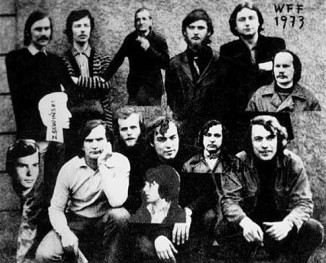Established in 1970 as an academic club at the Film School in Łódź, the Workshop of the Film Form was hugely influential in Poland for establishing the paradigm for investigations of “film as film” throughout the decade. Made up of an extended group of filmmakers with a broad range of interests, the WFF included most prominently Józef Robakowski, Wojciech Bruszewski, Paweł Kwiek, and Ryszard Waśko. Many workshop members later became major figures in Polish art and film. While at the workshop, they undertook experiments with the structure of cinematic production, aiming to release it from narrative and literary confines. Their work proved to be a highly subversive force in Polish experimental film as well as a center of creative rebellion at the workshop, which remained in existence until 1977. This program focuses on films that came out of the WFF, though it also includes two films—Winding Paths and Transformation—that were made by film students in Łódź but predate and postdate the workshop, respectively.
The WFF was remarkable both for the degree of freedom its members enjoyed and the quality of the professional equipment to which they had access. “Within the Studio the members were able to create their very own educational and research curriculum independent of the school’s requirements—whilst at the same time benefiting from its financial help and technical infrastructure. This is the reason why, as art historian Łukasz Ronduda points out, ‘the majority of their radical films were shot in the ‘Hollywood’ format of 35mm.’”
The influences that brought members together—from their earlier participation in amateur film clubs to their admiration for the prewar avant-garde filmmaker Stefan Themerson—also highlight the workshop’s pedigree as an “alternative space.” Additionally, the WFF, like the Balázs Béla Studio in Budapest, was notable for the degree to which it promoted collaboration between filmmakers and artists and encouraged filmmakers to work as artists, even bringing their work into the walls of the Łódź Art Museum.
Thanks to the research and publications of several curators and art historians, most notably Ryszard Kluszczyński and Łukasz Ronduda, informative texts, including those in English, are available on the legacy of the Workshop of the Film Form. Interested readers should look to them for broader context on the WFF as a cultural phenomenon.[1] Within this web feature, the introduction to the Medium Experiments program also offers additional information on the WFF members’ work in the medium of video. Numerous WFF films can also be seen either in part or in full in the on-line Filmoteka Muzeum, hosted by the Museum of Modern Art in Warsaw, which offers free access to hundreds of Polish artists’ films. Clicking on the film titles in this program will take the reader to the Filmoteka Muzeum pages on which the films can be watched. — Łukasz Mojsak and Ksenya Gurshtein

